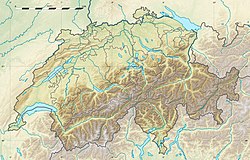| Alternative names | Sternwarte Hubelmatt |
|---|---|
| Location | Lucerne, Canton of Lucerne, Switzerland. |
| Coordinates | 47°02′06″N8°18′20″E / 47.0351°N 8.3056°E |
| Established | 1979 |
| Website | sternwarteluzern |
 | |
| | |
Hubelmatt Observatory (German : Sternwarte Hubelmatt) is an astronomical observatory in Lucerne, Switzerland, billeted at the city's Hubelmatt West School. Built in 1979, it is operated by the Astronomical Society of Lucerne (German : Astronomische Gesellschaft Luzern). [1]
On 12 February 2017, the inner main-belt asteroid 6126 Hubelmatt, discovered by Zdeňka Vávrová at Kleť Observatory, was named in honor of the observatory and its hosting school. ( M.P.C. 103029 ). [1] [2] This was an additional reward for suggesting the winning names "Helvetios" and "Dimidium" for 51 Pegasi and its exoplanet, respectively, as part of the 2015 NameExoWorlds contest. [3]
